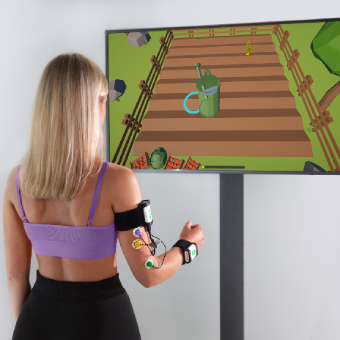Steadys-Kinematics/BFB
system for rehabilitation of movement activity and coordination with biofeedback
- training of movements skills and coordination
- motivating games
- manual and automatic training modes
- progress tracking

Description
Training of movement skills and coordination
Movement pathology involves many orthopedic and neurological disorders. Patients with serious injuries, musculoskeletal disorders, central and peripheral paralysis, paresis and other neurological conditions require restoration of the lost movement skills.
The core of the system, a miniature Neurosens inertial measurement unit (IMU) sensor, allows you to detect and record even the slightest movements that cannot be distinguished by the human eye, amplify them and use as biofeedback (BFB). This enables early rehabilitation.
Motivating games for effective rehabilitation
The gaming environment is important for the rehabilitation process as it helps improve subject cooperation and performance. The software features different animation options that ensure you get the most out of it with every training session. The BFB allows for rehabilitation of both movement and cognitive functions, which is an additional benefit for a comprehensive rehabilitation. Steadys-Kinematics involves various movement directions at the joint.
Manual and automatic training modes
It is important to assess task performance during the gait training to keep the patient motivated. If the patient fails to perform the task, you can make it easier without training termination or more difficult if the patient succeeds in the task. This is how it works in manual mode. The control of the training performance and adjustment of the task difficulty level in the automatic mode is done by the software that streamlines end-to-end workflow and helps to save time.
Progress tracking
All data obtained during the exams is stored in the software database. It only takes one button to generate a report for a comprehensive assessment of changes.
Delivery Set
The delivery set can differ from country to country. Request the actual delivery set for your country from your local representative.
| Neurosens IMU sensor | 2 pcs. |
| License for "Steadys-Kinematics" software | 1 pcs. |
| License for "Steadys-Kinematics" software with Rehabilitation software module | 1 pcs. |
| Charging cable | 2 pcs. |
| IMU sensor mount | 4 pcs. |
| License for "Steadys-Kinematics" software with EMG software module | 1 pcs. |
| Set of number stickers | 1 pcs. |
| Elastic strap (0.2 m) | 1 pcs. |
| Elastic strap (0.3 m) | 1 pcs. |
| Elastic strap (0.5 m) | 1 pcs. |
| Elastic strap (0.7 m) | 1 pcs. |
| EMG cable (0.2 m) | 1 pcs. |
| EMG cable (0.3 m) | 1 pcs. |
| EMG cable (0.5 m) | 1 pcs. |
| Disposable ECG electrode (D=26 mm, price for 1 pcs., comes in packs of 30 pcs.) | 90 pcs. |
| Software protection dongle | 1 pcs. |
| Holder for video camera | 1 pcs. |
| Wireless router | 1 pcs. |
| USB extension cable (USB2.0 USB A(m) - USB A(f), 5m) | 1 pcs. |
| Package set | 1 pcs. |
| Bottom box insert | 1 pcs. |
| Upper box insert | 1 pcs. |
| 23,8" Monitor | 1 pcs. |
| Technical Manual «Neurosens Set of IMU Sensors» | 1 pcs. |
| Technical manual «Steadys» | 1 pcs. |
| Annex to user manual «Exam Manager» | 1 pcs. |
| Warranty certificate | 1 pcs. |
Options
-
Стэдис_Декларация о соответствии_03.08.2022
666,55 KB
-
Свидетельство о регистрации ПО Стэдис-Кинематика
990,58 KB
-
Выписка из единого реестра российских программ для ЭВМ ПО "Стэдис-Кинематика"
192,5 KB
-
Стэдис_Регистрационное удостоверение_KZ_13.11.2024
677,09 KB
-
Свидетельство на товарный знак Стэдис
791,71 KB
-
Стэдис_Регистрационное удостоверение_RF_03.09.2025
14,89 MB






